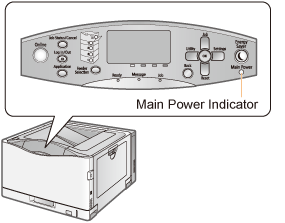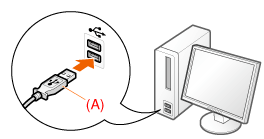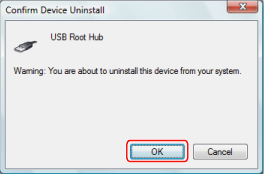Solution
Perform one of the following solutions according to the cause.
<Cause 1>
The printer is not turned ON.
<Solution>
Turn the printer ON.
<Cause 2>
The USB cable is not connected properly.
<Solution>
Make sure that the printer and computer are properly connected with the USB cable.
1. Make sure that the printer and computer are OFF.
Check if the Main Power indicator on the control panel is turned off.
2. Connect the USB cable.
- Flat end (A): Connects to a USB port on your computer.
- Square end (B): Connects to the USB connector on this printer.
* Do not turn the printer ON at this stage even if you want to install the printer driver.
<Cause 3>
The USB cable was already connected and the printer was turned ON before the printer driver was installed.
<Solution>
Perform the following procedure.
2. Disconnect the USB cable.
3. Connect the USB cable again.
4. While the following screen appears, turn the printer ON.
<Cause 4>
An inappropriate USB cable is being used.
<Solution>
Use a USB cable that is appropriate for the USB interface environment of the printer and has the following symbol.
* The following is the USB interface environment of this printer.
<Cause 5>
The USB class driver is installed.
<Solution>
Uninstall the USB class driver using the following procedure.
1. Confirm whether the computer and printer are correctly connected by a USB cable, and whether the printer is switched on.
2. On the [

] (Start) menu, click [Control Panel] - [Hardware and Sound] - [Device Manager].
If the [User Account Control] dialog box is displayed, perform the following operation.
If you have logged on using an administrator account, click [Continue].
If you have logged on as a user, enter the administrator account password and click [OK].

For Windows 10:
2-A. Click [Settings] - [Devices] - [Printers & scanners] - [Device Manager] in the lower right hand corner of the screen.

For Windows 8.1/Server 2012 R2:
2-B.From the desktop, display the charm bar to the right of the screen, and click or tap [Settings] - [Control Panel] - [Hardware and Sound] (or [Hardware]) - [Device Manager].

For Windows 8:
2-C. From the desktop, display the charm bar to the right of the screen, and click or tap [Settings] - [Control Panel] - [System and Security] - [Device Manager].

For Windows Vista:
2-D. Click [

] (Start) - [Control Panel] - [System and Maintenance] - [Device Manager].

For Windows Server 2003/Server 2003 R2/Server 2008/Server 2008 R2:
2-E-1. From the [Start] menu, select [Control Panel] (- [Performance and Maintenance]), and double-click the [System] icon.
2-E-2. In the [System Properties] dialog box, click the [Hardware] tab → click [Device Manager].
3. Delete the USB class drivers displayed under [Universal Serial Bus controllers].

Select the name of the printer you are using, then click [Uninstall].
Make sure you do not delete items other than USB class drivers. If you delete something else by mistake, Windows may no longer operate correctly.
If USB class drivers are displayed under [Other devices], they have not been installed correctly. Select the USB class drivers and delete them according to the operating system you are using.
4. If the [Confirm Device Uninstall] (in Windows Server 2003/Server 2003 R2, [Confirm Device Removal]) dialog box is displayed, click [OK].
5. Close [Device Manager].
6. Close [Control Panel].
7. Remove the USB cable from the computer and restart Windows.
8. Uninstall the driver, and then install the USB class driver. For details on the procedures for uninstalling the driver and then installing the USB class driver, see "Printer Driver Installation Guide."
IMPORTANT
If you cannot correctly finish installing the driver, be sure to uninstall the driver before attempting to re-install it.










 ] (Start) menu, click [Control Panel] - [Hardware and Sound] - [Device Manager].
] (Start) menu, click [Control Panel] - [Hardware and Sound] - [Device Manager]. For Windows 10:
For Windows 10: For Windows 8.1/Server 2012 R2:
For Windows 8.1/Server 2012 R2: For Windows 8:
For Windows 8: For Windows Vista:
For Windows Vista: ] (Start) - [Control Panel] - [System and Maintenance] - [Device Manager].
] (Start) - [Control Panel] - [System and Maintenance] - [Device Manager]. For Windows Server 2003/Server 2003 R2/Server 2008/Server 2008 R2:
For Windows Server 2003/Server 2003 R2/Server 2008/Server 2008 R2: Select the name of the printer you are using, then click [Uninstall].
Select the name of the printer you are using, then click [Uninstall].